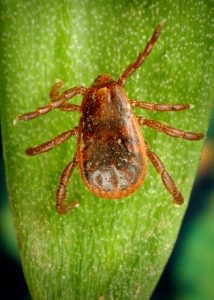We often get the question: “When are deer ticks active?”
The answer is often not what people want to hear, because the truth is that deer ticks (also known as blacklegged ticks — we use the terms interchangeably) are active during more of the year than you might assume. Ticks never die off, they just go into low-activity periods during the year. That means that during a warmer winter, they actually can be active year-round.
Based on both anecdotes and research, you need to protect yourself against ticks anytime the temperature is above freezing, even if it is in the dead of winter. We talk to lots of foresters and others with outdoor jobs who say that they pick blacklegged ticks off of themselves even on cold days.
The activity level for deer ticks usually begins to increase as soon as the snow is gone and temps are more consistently above freezing. As a result, it is not a bad idea to use tick repellent even on days when you think might be unnecessary.
When Do Deer Ticks Usually Come out?
Deer ticks, or blacklegged ticks, tend to “come out” as soon as the snow is gone and temps are  consistently at a thawing level. 35 degrees seems to be a magic number for tick activity, but there have been reports of them evening being active a few degrees below freezing. At around 50 degrees, deer ticks are usually moving around in full force.
consistently at a thawing level. 35 degrees seems to be a magic number for tick activity, but there have been reports of them evening being active a few degrees below freezing. At around 50 degrees, deer ticks are usually moving around in full force.
Ticks in northern climates like New England and the Upper Midwest tend to really get active in April. They move from a dormant state to a quite active state during this time, and between April and June, ticks are quite pervasive and common. In addition to adult ticks getting hungry, thsi is when young nymphs are active too. Nymphs are considered dangerous for transmitting Lyme disease, because they carry the disease just like the larger ticks but are much harder to notice. Some nymphs can be as small as a poppyseed.
Note that in warmer climates that host Blacklegged Ticks, like Virginia, Maryland and Northern Indiana and Illinois, the temp at which ticks get active is earlier than in Northern climates. In those areas, expect to see ticks really get active in March — but know they can be active year-round.
You can never let your guard down, but ticks tend to be slightly less active in the July and August months.
Then, in September, October, and early November, ticks are back out with a vengeance. During this stage, people also tend to be quite active because the weather is so nice. Hiking, hunting, bike rides, yard work, so it important to check regularly for ticks.
Is There a Time When Ticks are Most Dangerous?
As discussed above, ticks are dangerous year-round, and can transmit Lyme disease at any time. There does not appear to be a time when they are “more infected” than others. Infection rate of ticks is more a factor of where you are than of what season it is.
The April through June timeframe is the beginning of tick season and tends to be a particularly dangerous time, however, because this is when nymphs are active. Nymphs can be small that they are hard to detect. An infected nymph that attaches to you can transmit Lyme disease, and if you don’t find it for a couple days it is probably too late.
Do Deer Ticks Hibernate or Die Off in Winter?
No. It is a common misconception that blacklegged ticks are not around in winter. While some other types of bugs go into true hibernation in winter, or even die-off (leaving their eggs to hatch when the weather warms up), ticks tend to go into a dormant phase in winter. This is a little different than hibernation, because they can easily get active again if there is a stretch of mild winter days.
While the dormant season for ticks is normally spent in a clump of leaves, earth, or other organic matter, there is another way that ticks can do quite well over winter: By finding a host. A common winter host for a deer tick might logically be a deer. By attaching to a deer and conserving energy, it could hitch and ride and have a meal for a long time, and jump off in time for spring.
Obviously, during a shorter, warmer winter, as we have been seeing more of in recent years, this means that ticks can be more active during traditional winter months than they would have been during longer, colder winters.
When do Most Cases of Lyme Disease Occur?
Pinpointing when Lyme disease tends to occur can be tricky, because it is one of those disease with a weird timeline. It typically has an early flare-up that can be mistaken for a mild flu or  fever, then it can go away. Then, the disease can sometimes return weeks or months later with its difficult-to-control symptoms. Not every sufferer of Lyme disease gets the “chronic” version of Lyme disease.
fever, then it can go away. Then, the disease can sometimes return weeks or months later with its difficult-to-control symptoms. Not every sufferer of Lyme disease gets the “chronic” version of Lyme disease.
The National institute of Health (NIH) did some research on when we tend to see the cases of Lyme disease peak during the year. The excellent analysis found a few interesting trends.
First, as might be expected, the Lyme disease “season” in warmer states is longer than in colder states. Virginia tends to see its abundance of Lyme cases come in for more weeks per year than Maine, for example. The season peaks in Virginia between late April and early September. In Maine, however, the season might not begin until early June, and could be done by late August.
The “peak week” from the analysis was somewhere between mid-June and very early July, depending on location.
Keep in mind that these are peak times — you can be bitten by a tick almost any time of year, and that tick that bites you could transmit Lyme disease if it is a Deer Tick.
So What Can We Do to Keep Ticks Away?
You can take steps to keep ticks away. Several of the pieces we have written here focu son that very topic.
In short, though, the things we recommend you do include using the best tick repellent you can find. This is important, because ticks definitely are deterred by repellents in a big way. We suggest not getting too cute with the repellents, use the tried-and-true. Avoiding Lyme disease is worth it. Use DEET on your skin, and permethrin on your clothing and footwear.
Second, check for ticks early and often. If you come in from a long day in a tick-likely area, you need to check yourself. Make this a habit.






